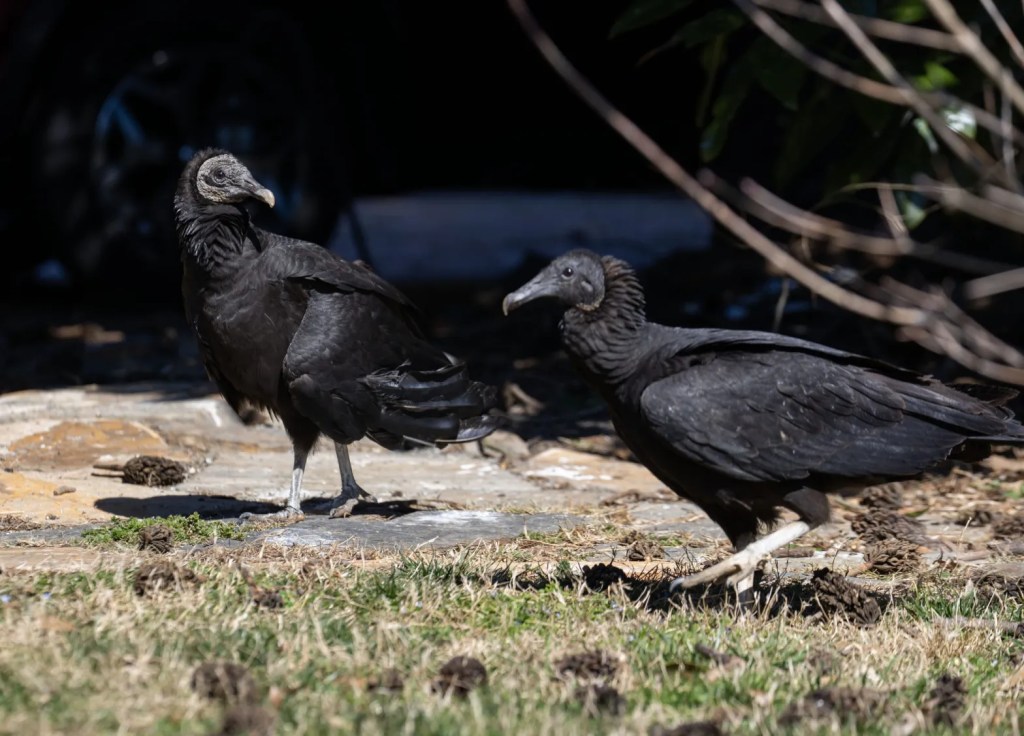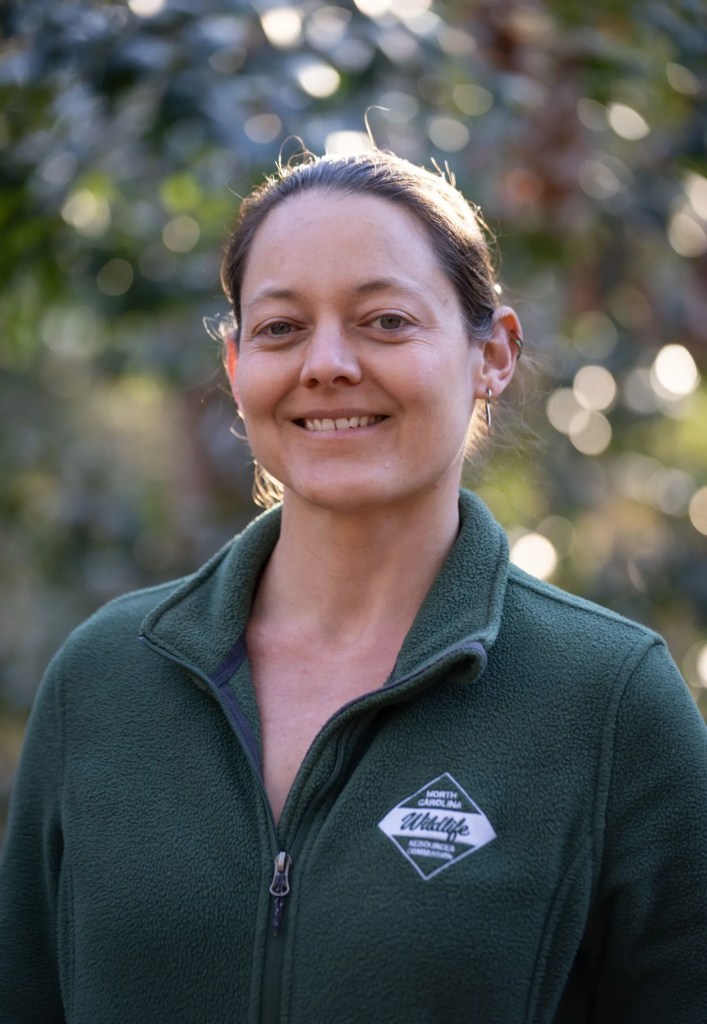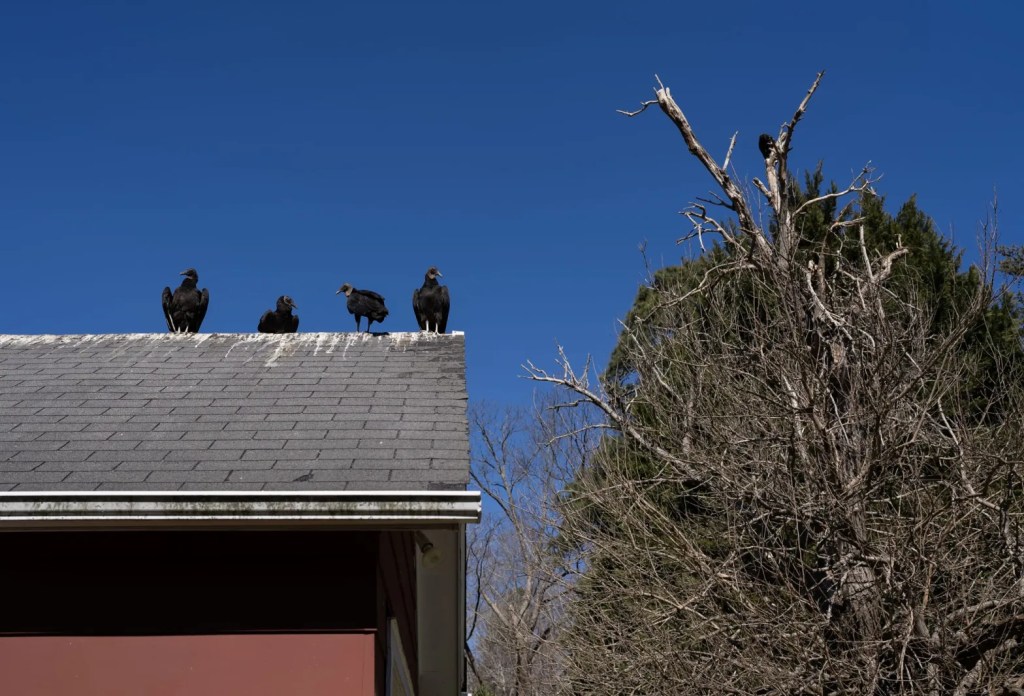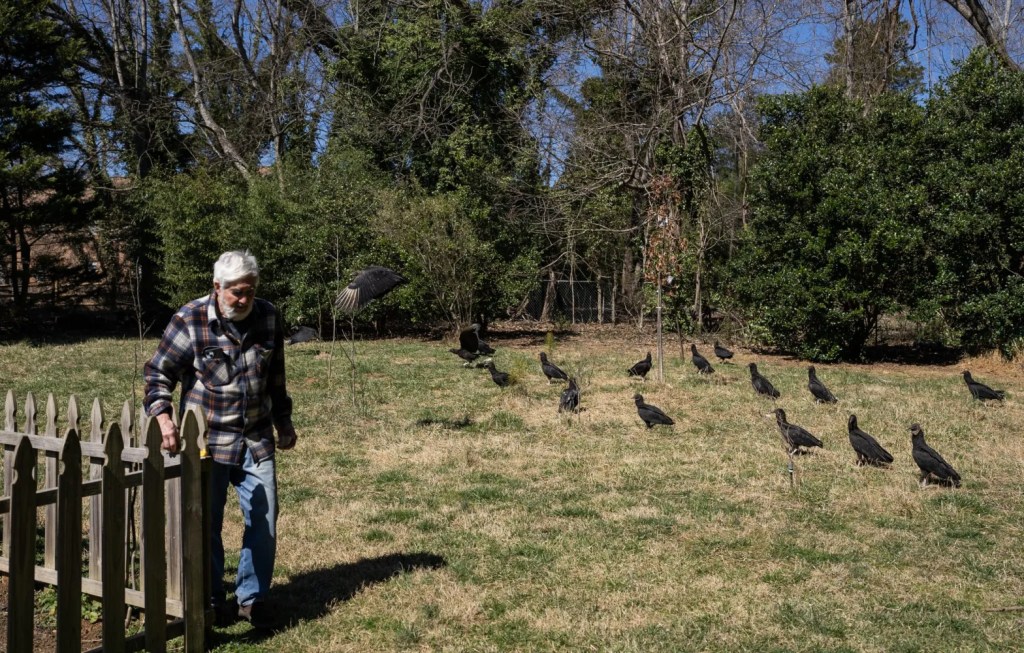This story originally published online at The Assembly.
The birds arrive early in the morning and leave before dark. Sometimes there are dozens, sometimes as many as 100. They gather on the lawn, on the roof, in trees, and on fencing. They are quiet, sociable creatures. When the sun shines, they lift up their wings to bask in its warmth.
Ken and Linda Ostrand love the birds that visit their backyard each day. But these birds are black vultures, and not everyone in their historic Hillsborough neighborhood shares their fondness for the feathered guests. The debate over what to do about them is civil, but it’s been going on for a long time and now town leaders are getting involved.
The Ostrands say the vultures came with their house. The previous owner tried unsuccessfully to run them off, but they always returned—drawn, the Ostrands think, by the large cleared yard on a southern facing slope. Surrounded with tall trees and buildings, it’s a perfect place for the raptors to lounge in the sun.
Shortly after they bought their house in 2017, the Ostrands installed fencing around their yard and in the process, offered the local vultures the first of many free meals.
“One of the workmen found a dead deer in the back and he said, ‘What do you want me to do with it?’ We weren’t quite sure what to do with it,” Linda recalled, so they moved the carcass to where the vultures could get it. “And it was gone in a day. It was amazing how thorough they are.”
After that, Ken said, they began offering the vultures meat scraps and leftovers from time to time, and put out water for them regularly.
Their neighbors Michael Beanland and his wife didn’t notice any vultures when they bought their house in 2020. But not long after, they were surprised at how many flocked to the yard next door, and how often.
Beanland didn’t respond to The Assembly’s requests for comment. But he recently told the Hillsborough Board of Commissioners that the Ostrands assured him the birds were migratory and would soon move on. Instead, he said, a pattern developed that has persisted for nearly five years.
While some of the vultures migrate as the seasons change, many stay local. The vultures regularly spill over into Beanland’s yard, where they have damaged roof shingles with their talons and coated his sidewalk with thick layers of excrement. He said he and his wife have found leftovers from meals the Ostrands put out for the vultures, “things we don’t want our dog and our children coming in contact with,” like meat trays from the supermarket, or bones from chicken and steak.
The situation reached what he called “a tipping point” in 2022, when he found several dead vultures in his yard that he believes died from bird flu.
Beanland estimated he’s contacted the Ostrands 10–15 times in the past few years, either in person or via email, asking them to stop feeding the birds. And for a while they would. Once, when the Ostrands went on vacation for two weeks, he said, the birds left entirely. But each time, the birds returned, and Ken and Linda offered them snacks.

Beanland told town commissioners he sent his most recent email to the Ostrands in December, once again asking them to stop. In response to this latest round of complaints, Ken said they’ve cut back on feeding the vultures since the holidays. Aside from two of the birds.
“One is Chester. If you’re a Gunsmoke fan, you’ll know that Chester has a bad leg, and in fact he can’t move it very well, but he can fly,” said Ken. “And the other one is Morticia. Morticia is unable to fly because of a bad wing, but they both recognize us to come around to try to get fed.”
Chester is shier, Ken said, and often flees when they toss food at him. Morticia, on the other hand, will get fairly close, allowing them to throw her scraps directly. Other than the two with obvious physical limitations, the Ostrands say they ignore the birds, but they show up anyway.
Linda, who ran a wildlife rehabilitation center on the outskirts of Hillsborough for seven years, believes vultures are widely misunderstood.
“They’re nature’s garbage cleaners,” she said. “I can understand that a lot of people don’t want them on their house because they’re not the most beautiful floaty little bird, but they do such a good job.”
The Clean Up Crew
Vultures play an important role in the ecosystem as scavengers, scouring the landscape for roadkill and other carrion. Their powerful stomach acid can neutralize botulism, anthrax, rabies, and other pathogens. And there can be severe consequences if they disappear. After widespread use of a veterinary drug for cows accidentally killed off nearly 50 million vultures in India in the 1990s, infections from bacterial diseases lead to the deaths of nearly 500,000 humans over a five year period, according to a study published in the American Economic Association journallast year.
“Very few people are fans of vultures. But they wouldn’t like their life and their world if we didn’t have them,” said Linda. “They’re here for a reason. Mother Nature makes very few mistakes.”
Vultures are highly intelligent, and despite their rancid diet, they don’t pose much of a health risk to humans, said Colleen Hartman, curator of birds at the Carolina Raptor Center near Charlotte. Still, their excrement is corrosive, thanks to their potent stomach acid, and they have a habit of projectile vomiting when alarmed. Most people prefer to appreciate them from a distance.
Beanland told commissioners he’s tried all he can to resolve the situation, and in January he petitioned the Town of Hillsborough for some kind of official intervention.
Board members agreed it might be time to take action, noting at their January 13 meeting that this issue has come up repeatedly and they’ve heard from multiple other neighbors voicing their displeasure.
“The emails that we’ve gotten show a lot of the issues that we have with trying to enforce anything,” said Commissioner Meaghun Darab. “Something on the books that says ‘Don’t Feed the Animals’ may have a little more weight behind it.”
Do Not Feed
Most people won’t go out of their way to cater to carrion eaters, but Falyn Owens, a wildlife extension biologist with the North Carolina Wildlife Resources Commission, says all kinds of people like to feed wildlife. Some are hunters, some are birdwatchers, some hope to catch glimpses of raccoons, possums, and deer.
“It’s definitely popular, but not necessarily mainstream,” she said.

Although wildlife officials discourage what they call “supplemental feeding,” there’s no statewide rule against it. Owens says regulation falls to towns, counties, or homeowner associations. Increasingly, towns and counties across North Carolina are trying to dissuade well-meaning residents from initiating feeding routines that can trigger unintended consequences.
Carrboro banned deer feeding within town limits in 2011 due to concerns about overpopulation and disease. Ocean Isle Beach banned wildlife feeding in 2023. Kure Beach town leaders in 2024 specifically targeted the practice of feeding gulls at the shore and nearby dunes.
Most of these rules include exceptions for backyard bird feeders, but in the mountains where black bears frequently roam, the stakes are higher. Elected officials in Buncombe County and in Asheville voted in 2023 to approve updated ordinances that require residents to remove bird feeders and similar food sources if bears or other wildlife start to frequent them. Violations of the county ordinance can result in fines of up to $500.
Owens and other wildlife experts recognize it can be difficult to convince people that feeding wildlife usually does more harm than good.
“Fundamentally, it’s an emotional issue,” said Owens. “They feel like they’re doing something really good when they feed wildlife. And, you know, it can be a challenge to have the reality of the consequences of doing that overcome the feel-good emotions that people get from feeding animals.”
Linda Bergman-Althouse has been rehabilitating wildlife for 30 years, caring for sick, injured, or displaced animals and releasing them back into the wild whenever possible. She serves as vice president of Wildlife Rehabilitators of North Carolina, a non-profit organization that supports wildlife rehabilitators statewide.
She says rehabbers spend a lot of time dealing with the aftermath of human interference. When people feed wildlife, it’s rarely food that’s good for them. Waterfowl can fill up on snacks like bread, popcorn, and french fries to the point where they don’t have room for food with actual nutritional value. And a high carbohydrate diet, the kind a duck might get at a pond in the park, could trigger abnormal growth patterns in the wings of young birds.
“It damages their wings, and basically their wings start degenerating over time,” said Bergman-Althouse. “You’ll see what we call grounded gulls, or grounded geese, they can’t fly anymore because their wings are so deteriorated that it just does not allow them for any lift off or anything. After a while, little wings start sticking out from their side. We call that angel wing.”
Some people love to put out corn for deer, especially in winter, but Owens says it’s basically the nutritional equivalent of ice cream. Too much corn can cause digestive problems, or even hoof deformities. And feeding stations of any kind where animals congregate can become places where diseases spread more quickly. For deer, it can spread Chronic Wasting Disease, a contagious fatal infection that showed up in North Carolina in 2022. Wildlife officials are hoping to contain it in a handful of counties and prevent statewide spread.
When wild animals get used to looking to humans for food, it raises the odds of conflict that rarely ends well for wildlife. An animal that one person might welcome in their yard could be deemed a nuisance or a threat by a neighbor.
Supplemental feeding causes larger scale problems too, Owens points out, as reproduction rates are tied to food sources.
“When you have these artificial feeding situations, in some cases, we actually see the population of these animals increase to the point where they are overpopulated in a way that’s very unnatural,” she said. “That can cause issues such as competition among animals, they might start fighting with one another, [or] they can spread diseases more easily if they’re overpopulated.”
Owens says offering wildlife the kind of foods they really should be eating pays off for everyone. Her advice is to skip the plants you might find at a typical garden center and seek out a native plant nursery instead.
“If you want to bring birds into your yard, plant some native wildflowers and allow those flowers to set seed and stay over the winter, so you can feed your birds naturally without having to put up a bird feeder,” she said.
“When you start planting native plants, you’re creating shelter, nesting locations, you’re creating a supply of food for our beneficial insects, which are then, for example, really important for baby birds. Baby birds don’t eat bird seed. Baby birds eat caterpillars. And caterpillars have to eat native plants.”
At the Wake
Collectively, vultures are called a kettle when soaring overhead, a committee when gathered on the ground, and, when they come together to feed, a wake.
The committee (or wake) at the Ostrand house is not the only one in town. Hillsborough authorities have been trying to deal with another group of black vultures that likes to hang around the police station downtown, damaging roof shingles and pooping on patrol cars.

Vultures are federally protected under the Migratory Bird Treaty Act of 1918, so there’s not a lot you can legally do to discourage them once they show up. Stephanie Trueblood, Hillsborough’s public space and sustainability manager, says town staff tried installing mirrors, sticky tape, and whirligigs to get them to move along, but to no avail. The only thing that has made a difference has been hiring a janitorial crew to keep the nearby dumpsters clean. Once the trash buffet shut down, some vultures lost interest.
Hillsborough officials are hoping for a similar outcome elsewhere in town. A month after Beanland petitioned commissioners for help, the board unanimously approved an ordinance banning the feeding of all wildlife in town limits, with exceptions for songbirds and pollinators. Violations can result in fines of $74 a day.
At the same time, Trueblood says the town is also publishing a wildlife guide to help residents live in harmony with everything from groundhogs to Canada geese.
“One of my main goals is to try to educate people about what it is these animals are looking for and how to deter them from your property but without harming them, because every single one of these animals provides an important role in the overall sustainability and ecology of the town,” she said.
While vultures are susceptible to bird flu, and situations where birds gather in large concentrations can spread the disease, Trueblood says concern about avian influenza hasn’t been the primary motivation for the new ordinance.
“The whole point of this activity is to reduce conflict with wildlife, but also to reduce conflict with neighbors because we want to be a responsive and respectful small town,” she said.
Ken and Linda Ostrand say they are skeptical of the new rule. They feel it’s unnecessary, intolerant, and, as Ken puts it, “much ado about nothing.”

But they have made some adjustments.The last meal they say they offered the entire committee was the turkey carcass from Thanksgiving. Since then, they report that the numbers of birds visiting the yard have dwindled slightly, though some still drop in to soak up the sun.
Chester and Morticia come by regularly and the Ostrands continue to offer them scraps, fearing the two have few other options for food.
Linda says she tried to catch Morticia many years ago to see if her wing could be reset, but the bird was too fast. Linda believes it’s likely been too long since the injury for rehab.
If she could catch them, she’d like to see Chester and Morticia relocated to the grounds of the Carolina Tiger Rescue in Pittsboro. The giant cats in captivity there feed on large amounts of meat, so there are plenty of carcasses left over for scavengers. She says she and Ken often took injured vultures out there when she ran her wildlife rehab. It’s a place where vultures “can live happily ever after, with breakfast served on a regular basis.”
But so far, Chester and Morticia have resisted any attempt at capture, preferring to visit the Ostrand’s yard on their own schedule.
“They’re still pretty fleet of foot,” said Linda. “They still know how to get away.”
Correction: This story incorrectly said Wilmington, N.C., banned the feeding of gulls, waterfowl, and other wildlife in 2016. It was Wilmington, Del.
Elizabeth Friend is a freelance reporter, audio producer, and writer based in Chapel Hill. Her work has been featured on the BBC, NPR, North Carolina Public Radio, and Longreads, among others.
